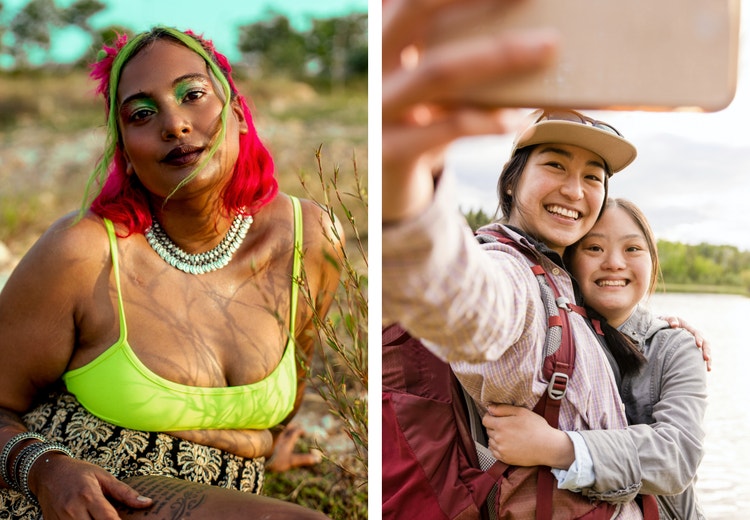As we celebrate Asian and Pacific Islander (API) heritage this month, we want to take the opportunity to look closer at how the API demographic is portrayed in popular culture and visual media. At Adobe Stock, we closely observe the way different demographics are depicted in pop culture and in campaign visuals, and we’ve seen API representation become more genuine and diversified in recent years. While this is a welcome shift, there’s still a lot of room to grow.
With Asian and Pacific Islanders representing 60 percent of the global population, we believe we have a responsibility to expand representation and access to the unique and intersectional tapestry of API communities. This drive towards more diverse representation is strong across major industry segments as well; a huge proportion of consumers from all backgrounds expect accurate, inclusive representation in visual media — and they demand it from the businesses they buy from and the media they consume. It’s clear many brands understand this, as the demand for more diverse depictions of people in stock imagery and campaign visuals continues to rise.
At Adobe Stock, we are excited by the photos, videos, and illustrations centering API experience our contributors are cultivating; we’d love to see more. With such a diverse community composed of a broad spectrum of countries, languages, and cultures, there's a wealth of perspectives and experiences to tap into for creative inspiration.
A 2021 study by the USC Annenberg Inclusion Initiative took a deep dive into the portrayal of API individuals in 1,300 popular films from 2007 to 2019. They found that API representation was severely lacking during that period. Only 5.9 percent of characters were API, and only 44 films out of the 1,300 depicted an API lead or co-lead, 14 of which were Dwayne Johnson. It’s clear that the film industry can do a lot more to represent the 4.7 billion Asian and Pacific Islanders living in the world today.
“Being CHamoru and Filipino, I often didn’t see many reflections of myself and my people in media growing up," explains Adobe Stock Contributor Jerilyn Guerrero. “It feels like animation is farther ahead in showing more AAPI representation with films like Raya and the Last Dragon and, more recently, Turning Red.”
Within the last year, we’ve seen refreshing new API narratives in films like Shang-Chi and the Legend of the Ten Rings and Everything Everywhere All at Once, but unfortunately, stereotypes and harmful tropes are still abundant. In 2019, 67 percent of API primary and secondary characters fell into token roles like the perpetual foreigner, model minority, sidekick, and villain.
“When it comes to media representation, I don’t think we’re there yet,” says Vaneesha Krish, creative consultant on a project called The Melanin Narrative, by Adobe Stock contributor Daniel Adams. “There’s been some progress, which is a good thing. For example, we now include Tamil women in mainstream Hollywood like Bridgerton, which is a huge thing for Tamil people everywhere. We loved that representation, but was it enough? No, not yet, because they’re in straight bodies. They’re not in fat bodies. It’s still fitting a standard. More can be done. Are we moving in the right direction? I would like to hope so.”
Asian and Pacific Islander Heritage Month
Creative assets from Adobe Stock.
Browse the gallery
Another report put out by the non-profit organization LAAUNCH: Leading Asian Americans to Unite for Change discovered that nearly 80 percent of Asian Americans feel like they aren’t respected and are discriminated against in the U.S. Since the start of the pandemic, Asian Americans have had to deal with a rise in racism and hate crimes, but we have a long history of discrimination against API communities. Dating back to xenophobic laws like the Chinese Exclusion Act of 1882, Asian Americans have dealt with stigmatization, intolerance, and racial bigotry for many years.
LAAUNCH found that Asian Americans have extremely low visibility in the media. 42 percent of respondents to their survey couldn’t name a single prominent Asian American. Only 14 percent of Americans said they saw Asian Americans in lead roles on television or in the movies, and nearly all cited examples of API characters were highly stereotypical roles. Even rarer is authentic depiction of Pacific Island characters and cultures specifically (Moana notwithstanding). It’s not surprising to see a growing market demand for more accurate and authentic API representation across mainstream media.
It’s important to include, support, and showcase artists of different ethnicities, intersections, and identities in Adobe Stock. Art and visual media are powerful tools to break through social barriers and illuminate diverse lifestyles, customs, and heritages that are typically underrepresented.
Adobe Stock contributor Mizuho Call’s illustrations depict the daily life, food, and language of her Japanese background. “When I graduated from college and started to work as a designer, I experienced so much racism,” she says. “I felt isolated because of my presence. I can't control how people act towards others, but I certainly can share a wider perspective by showing my culture. Right now, illustrations are my platform. There are many things that we can relate to as humans, and I feel the urge to tell people about it."
Consumers are vocal in their desire to see an increase in accurate representation. More and more, people expect to see themselves in advertisements and popular culture. Not just through stereotypical or tokenized portrayals, but in faithful depictions of actual everyday life for millions of people around the world. The Melanin Narrative is a good example of the expanding territory of API representation. “Popular media has typically excluded Southeast Asian communities of color,” explains Ron Jeyathurai Backus, creative consultant and model on the project. “What you’ll usually see is bronze-toned individuals who are very exoticized. It’s never people who look like me. So, that’s why this project was focused on what we call the dark-skinned community, but also specifically tailored to the Malaysian Tamil ethnicity.”
“I see this conversation as part of the zeitgeist right now,” says Irene Malatesta, senior content marketing manager at Adobe Stock. “A lot of high-profile Asian actors and actresses are getting the spotlight. It’s really refreshing.” As a culture buff and the daughter of an Asian immigrant, Malatesta finds API representation personally inspiring and meaningful. “When I was growing up, there were really only a few stock characters that Asians seemed to play in American films. They didn’t often get to be protagonists. When I see a film like Everything Everywhere All at Once, where a mature, Asian immigrant woman is the protagonist, I appreciate that on a personal level.”
Inspiring trends to guide authentic API representation
The media industry is taking notice. Top films of 2021 featured almost eight times as many API leads as the top films from a decade ago, according to a report by The Representation Project. Television shows like Almost Paradise, As We See It, and Killing Eve characterize API women in positive ways. Big brands are also doing better in their campaigns. Television commercials like "Traditions Shared” by Panda Express and Barbie’s “A Doll Can Help Change the World” showcase Asian American families and traditions.
“It’s exciting to see AAPI creators and stories being celebrated and shared. I love discovering something new that I haven’t seen or heard of myself,” says Guerrero.
We're seeing trends in advertising campaigns centered around the API demographic that highlight family and heritage, anti-racism and empowerment, and technology trendsetting. These themes are driving engagement with API audiences. There's a huge market demand for this type of stock content — content that portrays realistic experiences of the routines and daily lives of API communities.
“It’s a dichotomy that people tend to view any culture either very concentrated or not at all," says Indian culinary photographer and Adobe Stock contributor Simi Jois. “It’s not how most people live. Lifestyle is very integrated with culture. That’s something that most people don’t understand, and that’s part of educating the audience.”
Raise your voice — share your narrative
The demand for contemporary and accurate imagery centering the daily experiences of Asian and Pacific Islanders, and those of API heritage, continues to grow. Adobe Stock invites artists of all backgrounds to check out the Adobe Stock Advocates program, get inspired with our creative briefs, and contribute your best work. Upload and sell your photos, videos, and illustrations centering on diverse API identities and experiences on Adobe Stock and be a part of expanding the mainstream visual landscape through stock imagery.








